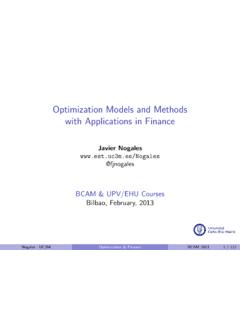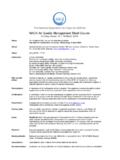Transcription of AERODYNAMIC ANALYSIS OF AXIAL FAN UNSTEADY …
1 University of the Basque Country - Euskal Herriko Unibertsitatea-Universidad del Pa s VascoFaculty of Science and Technology- Zientzia eta Teknologia Fakultatea-Facultad de Ciencia y Tecnolog aM aster en Iniciaci on a la Investigaci on enMatem aticasMaster ThesisAERODYNAMIC ANALYSIS OFAXIAL FAN UNSTEADY SIMULATIONSS eptember 2012 AuthorImanol Garc a de BeristainAdvisorsF. Palacios & L. RemakiAgradecimientos (Acknowledgements)Me gustar a mostrar mi agradecimiento a todo aquel que haya contribuido a la creaci on de estatesis de alguna Basque Center for Applied Mathematics for the trust they put on me. Specially to SergeyKorotov for letting me join up his group. To Francisco Palacios for his help and patienceduring my beginnings in the field. At last, thanks also goes to Lakhdar Remaki for helping mefinishing this thesis and introducing me into my next as mismo al Servicio T ecnico de Inform atica Aplicada a la Investigaci on de laUPV/EHU, por haberme facilitado el uso de STAR-CCM+ en mi ordenador ultimo, mi m as sincero agradecimiento para todos aquellos con los que he compartido eld a a d a de este largo a no.
2 Gente que todav a sigue ah y gente que ya no esta. Por supuesto,tambi en a mis padres por llevar conmigo esta ANALYSIS of AXIAL Fan UNSTEADY SimulationsAbstract:The objective of this thesis is to understand turbomachinery UNSTEADY CFD simu-lation performance depending on the turbulence model selected. For this porpoise, simulationswith two in industry extensively used turbulence modes have been carried out:k andk models. Simulations were performed using the commercial software STAR-CCM+. Resultshave been compared between them and with analytically obtained simplified solutions. Thiswill allow to judge real industrial case Rate results showed the same mean value downstream the fan for both turbulence mod-els. However, oscillations induced by UNSTEADY condition had different amplitudes. Boundarylayers have been studied as well. It wasn t found any difference among both turbulence mod-els results, but simplified analytical problems solution predicted smaller boundary layers thanSTAR-CCM+ obtained two main conclusions.
3 First,k is overpredicting blade performance comparedtok turbulence model because the second is more dissipative. However, if whole fan isconsidered, the extra blade efficiency onk turbulence model is lost because of biggerrecirculation zones. The second conclusion is the need for further understanding on boundarylayer simulation, since deviations from expected results by both turbulence models can not beaccurately explained by the author. However, it is probably related to surface curvature orblade edge pressure-gradient induced streamline :CFD, aerodynamics, AXIAL fan, boundary layer, alisis Aerodin amico de Simulaciones No Estacionarias de VentiladoresAxialesResumen:El objetivo de esta tesis es comprender la dependencia de los modelo deturbulencia en simulaciones no estacionarias de ventiladores axiales mediante CFD. Coneste fin, se han realizado simulaciones empleando dos modelos de turbulencia ampliamenteutilizados en la industria: los modelosk yk.
4 Dichas simulaciones se llevaron acabo empleando el software commcercial STAR-CCM+. Los resultados con los diferentesmodelos de turbulencia se han comparado entre si, y con las soluciones anal ticas deproblemas simplificados. Con esto se pretende ser capaz de valorar las simulaciones decasos industriales resultados muestran una media de aire igual para ambos modelos de embargo, las oscilaciones alrededor de esta media son diferentes para ambos resultados de las capas l mite son independientes respecto del modelo de turbulenciaesperado. Sin embargo, los modelos anal ticos simplificados predicen capas l mites m aspeque nas que las obtenidas mediante han obtenido dos conclusiones principales. Primero, el empleo del modelok resultar a en un rendimiento de alabe mayor que el obtenido mediantek , debido a queel segundo modelo es m as disipativo. Por otro lado, si se considera el ventilador en suconjunto, el empleo dek no supondr a una mayor eficacia porque tambi en implicareflujos mayores.
5 La segunda conclusi on es la necesidad de un mejor entendimientosobre la simulacion de las capas l mite puesto que no se ha logrado explicar de formaconvincente la diferencia entre los resultados esperados mediante modelos simplificadosy las simulaciones. Lo m as probable es que se deba a la curvatura de la superficie o a lacurvatura de las lineas de flujo inducidas por gradientes de presi clave:CFD, aerodin amica, ventilador AXIAL , capa l mite, Introduction12 Turbomachinery and Centrifugal Fans Essentials .. Fan Aerodynamics .. Characteristics of the Fan Flow Aerodynamics .. CFD Basics .. Physics Modeling .. Closure .. Solution Techniques .. 113 Reynolds Equations .. Stresses .. and Tensor Properties .. Turbulent Boundary Layer .. Equations and Velocity Profiles .. Energy and Reynolds-Stress Balances .. Limitations .. Mixing Length Theory .. Eddy Viscosity Based Turbulence Modelling.
6 Viscosity Hypothesis .. Treatment .. Two-Layerk .. SSTk .. 284 Set-up .. Results .. Flow .. Layer .. 365 Conclusions and future work39 Bibliography41vChapter 1 IntroductionResearch and investment in technology is often driven by market or legislation is subject to the same conditions and fans are not an exception. For example,noise damping orNOxreduction in aircraft engines are new research-lines driven by new normat-ive constraints. On the other side, stage efficiency is many times imposed by the manufactureritself to keep competitiveness in the market. Stage efficiency translates into specific aerody-namic performance requirements. New components will need much greater complexity duringits design, including a higher degree of three dimensionality ANALYSIS and flow-path tools traditionally available in engineering, such as basicrelative velocity triangles, havestrong limitations to comply with demanded complex research.
7 The use of advanced aerody-namic tools have to be developed. At this point Computational Fluid Dynamics (CFD) isbeing extended in the turbomachinery community to fulfil this task. Its ability to simulate flowphysics at any point in the domain, with better predicting capabilities every year, is extremelyattractive. CFD has already upgraded design of turbomachinery from 2-D inviscid flow modelsto 3-D, viscous, turbulent ANALYSIS [Earl Logan and Roy, 2003].In this thesis UNSTEADY simulation of an AXIAL fan flow field is studied. Although aerodynamiccomponents such as boundary layers or recirculation zones are considered, boundary layers takemost of the weight of the thesis, since blade performance is directly related to phenomena suchas boundary layer thickness or boundary layer detachment. Although boundary layers havebeen target for research for many decades, they are still under study. It is the case of aero-engines, which consider boundary layer induced vortexes because of the impact in aeroelasticity,blade thermal resistance, or noise generation.
8 For this reason it was found appropriate to focusthis thesis on a basic and yet extremely valuable boundary layers modelling is strongly dependant of viscosity an Reynolds Stresses. For thisreason, turbulence modelling is included besides boundary layers theory. In view of the extensivearea of turbulence in bibliography, it was decided to cover the basics of Reynolds AveragedNavier Stokes (RANS) models, which will be linked to the boundary layer theory during thesis is structured in five main Chapters. Chapter two introduces the basics of turboma-chinery aerodynamics and CFD. It also gives an overview of the state-of-the-art in the covers from airfoil lift explanation to latest trends in CFD simulations. Chapter three is thetheoretical core of the thesis. Starting from the Reynolds Equations, boundary layer structure isdeduced, to conclude with how turbulence is modelled within STAR-CCM. In Chapter four theSimulation set up and its results are reported such that it can be reproduced by the interestedreader.
9 At last, the conclusions are explained in Chapter 1. INTRODUCTIONC hapter Turbomachinery and Centrifugal Fans EssentialsTurbomachinery is found everywhere in the modern world. This big family of machines includepumps, turbines and fans. The essential components are therotor, which obviously is rotating;ashaftfrom which the energy is extracted or added to the rotor and acasingwhere the shaftstems from. Fluid is introduced through pipes in the case. Turbomachinery works transferringenergy between fluid and rotor. When energy is extracted from fluid, the machine is calledturbine, in the opposite case it will be apump, rotor is mainly made from blades. This blades have a specific shape in order to make thefluid flowing between two blades to execute a specific force on the blades. It is commonly findas well some fixed components in order to drive the fluid are other ways of turbomachinery classification. A common way is the rotor flow exitdirection: AXIAL , radial or mixed.
10 AXIAL : Fluid flow is parallel to the axis. Ideally there is no radial component of the flow,only AXIAL and tangential Radial: Fluid flow is orthogonal to the axis, there is no AXIAL velocity of the fluid. Mixed: The flow has 3 velocity components within the rotor: AXIAL , radial and to Bleier [1998], there are 4 types of AXIAL flow fans,1. Propeller fans (PFs)2. Tubeaxial fans (TAFs)3. Vaneaxial fans (VAFs)4. Two-stage AXIAL -flow fansPropeller fan, sometimes calledpanel fan, is the most commonly used fan in any kind of applic-ation or fans have a cylindrical housing. Gas exhaustion is the most common application forthis fans. The main negative outcome is the fast increase in the outlet duct friction losses dueto air spin. When venturi inlet is used instead of a duct friction losses are reduced about 10 %of and noise level fans has a housing, like tubeaxial fans, but they have guided vanes that neutralizesthe spinning air, so the unit is usable for blowing and exhausting (exit and inlet ducts).







